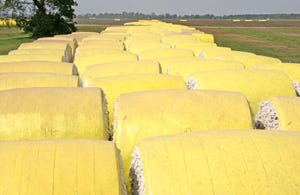
With the cotton harvesting season near, ginners need to pay attention to practices that can save energy — and money — and to carry out measures to enhance safety of workers, says Rick Byler, research leader at the USDA-ARS Cotton Ginning Laboratory at Stoneville, Miss.
“It’s not likely that the price of energy is going to go down, and we need to find ways to reduce the amount of energy used in the ginning process,” he said at the joint annual meeting of the Southern Cotton Ginners Association and the Delta Council Ginning and Cotton Quality Committee.
“Bobby Hardin, one of our scientists, is looking at ways this can be accomplished. His studies indicate that some gins use almost twice as much energy per bale as others, and there are things those gins can do to reduce their energy use and costs.
“We’ve done surveys for years on how much electricity gins use, but he’s been putting measurement devices on almost all of the energy-using equipment in the gin to determine exactly where energy is being used and how much is required per bale. Then we can figure out where improvements/savings can be made.”
One of Hardin’s projects shows that an operating gin uses nearly as much energy, whether cotton is being ginned or not, Byler says.
“If you have the last gin stand only half loaded, you’re wasting a lot of the energy needed to run that gin stand and the following lint cleaner. I know it’s hard to keep all the gin stands fully loaded all the time, but that’s a key to reducing your energy use per bale.”
Also, he says, a study has been done on energy savings related to gin breakdowns.
“When you have a breakdown, is it more efficient to turn off the equipment or leave it running while repairs are made? Our work shows that 12 minutes is the dividing line — if your repairs will take longer than 12 minutes, you’ll save money by shutting down; if less than that, let it run. We know some gins just let the equipment continue to run regardless of the time involved for repairs, but they’re needlessly using energy by doing that.”
Gins that process the new round modules need to pay attention to their handling and safety, Byler says.
“On the gin yard, it’s important to leave room between these modules for air to circulate. If you put them too close together and it rains, then the sun comes back out, you can have rotten spots from moisture accumulation.
“There are concerns too, about safety in handling these modules. You’ve got a heavy, round object to manage. Make your employees aware of the potential danger in handling these modules, and don’t let them get in situations where they could be crushed.
“Also, there is a lot of plastic material that has to be slit and removed before the module goes into the ginning process, so don’t let employees get in places where they could be injured by the cutting mechanism. If you’re expanding or buying handling equipment for these modules, consider the potential safety issues involved.
Be proactive against contamination
“Be careful to remove all the plastic cover material to prevent it from going through the ginning process and contaminating the bale.”
U.S. cotton has a reputation with mills for having low contamination levels, Byler says, “But gins must continue to be vigilant to keep contamination at a minimum. Some of the major contaminants that get through lint cleaners and into cotton bales are plastic mulch, irrigation tubing, grocery bags, and flagging tape.”
Among research projects under way at the Stoneville, Laboratory, he says, are a number of studies examining non-lint content sources at the gin.
“Cliff Boykin, an agricultural engineer, is studying seed coat fragments, which are a problem for mills. They come from a number of different places in the gin and on the farm.
“He is also looking at the effect variety cultivars — genetic properties of cotton — have on ginning. Every ginner has long known that some cotton varieties gin easier than others, but we’ve never tried to pinpoint what makes that difference. The harder it is to pull fiber off the seed at the gin stand, the more energy it takes for ginning.
“Can a geneticist enhance cotton varieties with properties that will make ginning easier? Research indicates it can be done, and genetics/DNA studies are under way with ARS collaborators Efrem Bechere and David Fang.”
While dust from gins hasn’t been a significant problem in the Delta, Byler says, “The EPA has rules about dust, and in some areas of the country it is a big problem. But, we haven’t had much good, solid data on what constitutes a dust problem. If we want to change the EPA rules, we have to prove that our data are scientifically sound.
“We’ve been collecting data from all over the cotton belt, spanning several years, and now have a huge amount of data that are being analyzed and papers being written. We would hope to have some definitive conclusions within the next year or so.”
Lower rates work best
While many gins have been increasing capacity in recent years, some haven’t expanded their seed cotton cleaning equipment, Byler says.
“In many cases, they are putting through considerably more seed cotton per foot of width than in previous years, and it’s often greater than the amount recommended by the manufacturer. Gins commonly operate at 3 to 4 bales per hour per foot of width. We’ve tested rates up to 6 bales per hour per foot of width — far higher than any gins presently operate.
“We found that more non-lint was removed by the first stage cylinder cleaner and stick machine at the lower rates. When you load these machines up, as many gins are doing, you aren’t getting the trash out as efficiently. While most gins don’t have a problem with trash, the increased efficiency at the lower rates may merit consideration.
“We were concerned that we’d be pushing good lint down through the cleaners and would lose lint, but fiber loss was only affected by processing rate for one of six cultivars tested — significantly more fiber was lost at all rates for that particular cultivar. There was no effect on leaf grade after one lint cleaner, with the extractor feeder and lint cleaner operated at the low rate, and no effect on fiber quality.”
Cotton classing fee will remain unchanged at $2.20
Other research is on ways to improve lint quality, moisture content, bale packaging, and automated gin controls.
“One areas we’re studying is reclaiming lint from material rejected by the seed cotton cleaners,” Byler says. “We found there was about 19 pounds of cleaned-up material per bale from the trash. It wasn’t as good as the regular lint, but it was pretty good. Of that, 7 pounds was loose lint, 7 pounds was motes, and 2 pounds was seed cotton (mostly seed).
“About 10 pounds of this material was retained after the gin stand lint cleaner, and could be added back to the bale and sold. There was no scientifically significant difference in HVI APHIS or spinning data whether or not this material was added back to the bale.
“However, mills have made a fuss about it, and there are some who really don’t want gins to do this. They say if they find out it’s being done, they won’t buy the bales. They don’t object to using the material for the manufacture of certain products, but they want to buy it separately and add it themselves.
“We’re going to continue to work on this to see where this material is coming from. We haven’t analyzed enough data, but doesn’t appear that it’s because too much seed cotton is being pushed through the lint cleaners; rather, it may be related to variety.”
Bale moisture content continues to be an issue for ginners, Byler says.
“Some gins are adding moisture to lint after it has been ginned. If you add moisture after ginning by any method, you need to manage the process at all times, especially during slow ginning.
“Bales have been ruined by adding moisture. When you slow the ginning process, you should also slow down, reduce, or turn off moisture restoration.”
Studies are continuing, Byler says, to collect data on moisture measurement systems.
Excessive short fiber continues to be a complaint by mill buyers, he notes.
“They’re very complimentary of most other aspects of U.S. cotton. Short fiber content is related to cotton variety — some varieties will just naturally be lower than others — but it also is affected by the ginning process.
“If you over-dry and gin at low moisture, you’ll have lower uniformity and more broken/short fibers. This problem can be addressed by the gin. We’ve been talking about this for years, and our advice still is: Gin at as high moisture level as you can and keep drying to a minimum.”
About the Author(s)
You May Also Like




